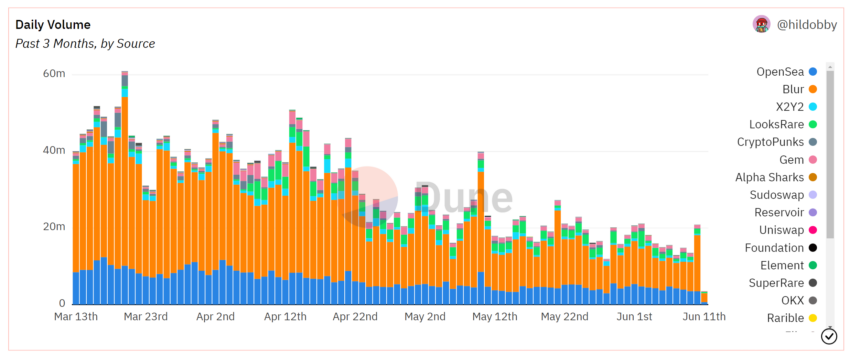NFT liquidity has taken a dive as marketplaces fiercely fight over a smaller pooler of traders and investors. In response to the trends, some marketplaces are offering incentives to keep traders on their platforms. Will it work?
NFT liquidity refers to the ease and availability of buying and selling non-fungible tokens (NFTs) in the market. When NFT liquidity is high, willing buyers and sellers abound, enabling smooth and active transactions. On the other hand, low liquidity indicates a drop in trading activity and a challenge in finding counterparties for trades.
NFT Daily trading volume continues to decline
According to data from Dune, daily transactions have declined steadily over the past 3 months. On March 13, approximately 44,000 NFT transactions took place. However, by June 12, that number was closer to 25,000.

Source: Duin/@hildobby
According to the recent DappRadar report, sales of NFT are expected to fall below $1 billion in May 2023 for the first time this year. Although the full story is not so simple.
In the report’s analysis, active portfolios related to NFT activity saw a 27% increase in May. The growth was attributed to the Miladys NFT collection, which received a significant boost from Elon Musk.
Start your NFT trading adventure today and master the fundamentals: How to start NFT trading: a step-by-step guide
To counteract declining trading activity, NFT marketplaces are reinforcing incentives for traders, as Samuel Haig noted in The Defiant on Tuesday.
On June 7, Blur, the NFT marketplace, announced updates to its incentive system for NFT traders. In its statement, Blur emphasized rewarding bidders who take real risks with the highest number of bid points.
The platform will now award $BLUR rewards to users who actually contribute to Blur’s growth, according to a Twitter thread. However, certain underhanded tactics will no longer be effective, including transferring NFTs for loyalty, performing wash trading, and spoofing bids.
LooksRare launched its own rewards season
LooksRare, whose daily volume once reached hundreds of millions of dollars, has been on a decline since May 2022. Now activity is consistently below $10 million. LooksRare, however, wants to reclaim its former glory by announcing its own rewards season on June 1.
Undeterred by low trading volumes, Kraken launched its own NFT trading platform earlier this month, further crowding the market.
As of mid-May 2023, Blur is still the largest NFT marketplace, according to DappRadar. It has an impressive 62% market share, while OpenSea lags behind at 26%.
Still, OpenSea has the largest number of traders, with 104,882 active users in the week leading up to the release of the DappRadar report, surpassing Blur’s 12,747.

